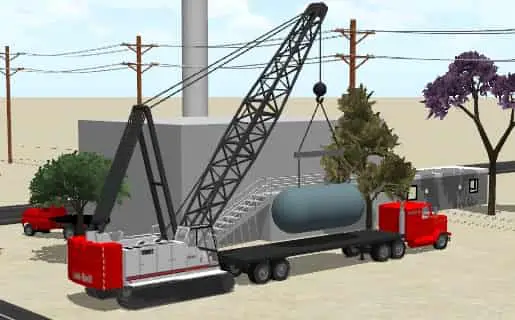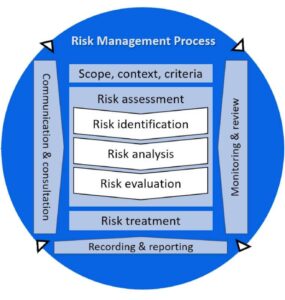How to make crane lifting plan

crane lifting plan
How to make Crane lifting plan is an important topic for learning for all lifting supervisors, and especially for the safety professionals lifting is a very critical activity. in the article, we will discuss lifting procedure
1.0 PURPOSE (How to make crane lifting plan)
This standard establishes guidelines for the safe operation of cranes, derricks, mobile cranes, vehicle-mounted hoists and Hiabs, and suspended personnel platforms and articulated boom platforms.
2.0 PROCEDURE
2.1 GENERAL
How to make crane lifting plan. All lifting equipment shall be capable of satisfactorily completing a thorough performance (operating) test and examination, by a competent person/ authority, before being placed into service on the project. Such a test and thorough shall be repeated after every substantial alteration or repair affecting its strength or stability, and in any circumstances in the case of hoists, every six months, and in the case of cranes, grabs or winches, etc., every fourteen months. Note: One copy of the current inspection results, signed by the inspector and the date the inspection was conducted, shall be forwarded to the Safety Manager at the site office.
Every piece of lifting equipment shall be inspected at least once a week, by a competent person Details of these inspections shall be documented and filed.
The crane operator shall perform daily inspections on all equipment before the crane is put into service. The results of the inspection shall be recorded in the logbook provided. At the end of each year, the original signed daily inspection log shall be sent to the Safety Manager at Head Office.
All rigging equipment shall undergo a visual inspection prior to each use.
Crane/ hoisting equipment operators shall be adequately trained and shall operate the equipment within the design limits.
The manufacturer’s specifications and limitations applicable to the operation of any and all cranes, derricks, and hoists shall be followed. Where the manufacturer’s specifications are not available, the limitations assigned to the equipment shall be based on the determinations of a competent person. Such determinations will be documented and recorded. Load capacities, determined by the performance test, recommended operating speeds and special hazard warnings or instructions shall be posted where clearly visible to the operators of cranes and derricks. At no time shall a crane or hoist be loaded in excess of the manufacturer’s recommended workload except during performance tests. All capacities shall be clearly indicated on lifting devices.
A suitably qualified supervisor shall be designated to determine the methods and develop plans for rigging operations to ensure safe lifts. All lifts shall be monitored to ensure acceptable lifting practices are being followed.
How to make crane lifting plan. For lifts in excess of 50 tons, or classified as critical (exceeding 90% of the crane capacity chart, any two-crane lift or any lift over operating or occupied facilities, process pipe racks or near power lines) a detailed rigging plan, including supporting calculations, shall be developed for review and acceptance prior to lift. Tag lines shall be used on all lifts. You can also see What is excavation safety
All load drums on load hoisting equipment shall be equipped with at least one positive holding device. This device should be applied directly to the motor shaft or some part of the training gear. Braking equipment capable of stopping, lowering and holding a load of at least the full test load shall be provided. Emergency rescue procedure
There shall be at least three full wraps of cable on the drums of hoisting equipment at all times. Whenever a slackline condition occurs, prior to further operations, the proper seating of the rope in the sheaves and on the drum shall be checked.
All windows in crane cabs shall be of distortion-free safety glass, or equivalent, that will not interfere with the safe operation of the machine.
A load radius chart and boom angle or radius indicator, as required for the particular type of crane, shall be provided within the operator’s view. A means shall also be provided for the crane operator to determine the levelness of the crane. Working at height safety
All cranes with cable-supported booms shall be equipped with boom stops to resist the boom falling backward, or with a properly functioning boom hoist disengaging device which shall automatically and completely disengage the boom hoisting power from the boom hoist drum when the boom has reached its highest-rated angle, as applicable to the particular type of crane. Risk inside confined space
All cranes will at all times have a current set of operator manual(s) for the particular model/type/class crane. The operator manual(s) shall be located in the crane cab prior to testing and shall remain there.
Hand signals to the crane or derrick operators shall be those prescribed by ANSI or BS 721 for the type of machine in use. An illustration of the signals shall be posted in the operator’s cab and one shall be displayed at a highly visible location for the signal person/ Banksman to see. Operators shall accept signals only from the designated signal person, except for the STOP signal that may be used by all personnel.
The counter-weight and housing swing radius shall be properly barricaded wherever it is possible that a person may come into contact with or be struck by them.
Riding on loads, hooks, hammers, buckets, material hoist or other hoisting equipment not meant for personnel handling, is prohibited.
2.2 SUSPENDED/ELEVATED PERSONNEL PLATFORMS
A Platform Lift Procedure shall be developed prior to use. The procedure shall include operator and employee training, pre-lift meetings, design considerations/ summary, tests and trial lifts, and platform inspection.
All operators shall be suitably trained and qualified. Training records shall be documented and maintained.
The platform/ basket shall be designed by a qualified engineer. Locking devices for crane suspended personnel platforms shall be included in the design and/or tested prior to use. Crane free-fall capacity, if present, shall be positively locked-out or disabled. The maximum carrying capacity shall be clearly indicated. The area under the lift shall be isolated by barrier tape and signs. What are fall protection systems for scaffolders
How to make crane lifting plan. A positive means of communication shall be provided between the crane operator and personnel in a crane suspended personnel platform. All persons inside the platforms shall wear a full-body harness attached to a designated anchor point. A fire extinguisher shall be provided at each platform. Equipment used to hoist personnel shall not be used to hoist material if the Safety Officer considers this to be hazardous.






